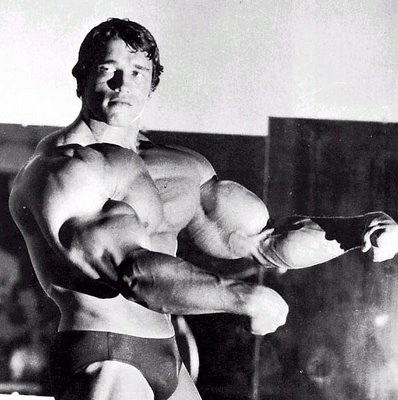 Here you have the training schedule of J.P. Patches in the picture combined with Arnold. I want to post some pics of big arms and some training “secrets” of the Old School” bodybuilders. I.m.o. Arnolds arms were the best ! Flexed ,relaxed all angles. In his side chest pose his arms are unbelievable. Dense, proportionate and symmetrical . Thank God the word “Synthol” wasn’t known then.
Here you have the training schedule of J.P. Patches in the picture combined with Arnold. I want to post some pics of big arms and some training “secrets” of the Old School” bodybuilders. I.m.o. Arnolds arms were the best ! Flexed ,relaxed all angles. In his side chest pose his arms are unbelievable. Dense, proportionate and symmetrical . Thank God the word “Synthol” wasn’t known then.
Most bodybuilders want impressive arms, but wanting and getting are two different things. Some of you will not be able to reach the mark you desire, and some of you will. If you’re looking for some magical shortcut to this goal I have no secret formula, but will be glad to tell you what type of training proved satisfactory for me.
To those of you who are having trouble at this time with developing the arms, maybe the way I trained will help. You won’t know until you have tried it for yourself, and don’t let anyone tell you one way works for everyone. It simply isn’t true. Once you have learned, studied and practiced the basic movements it is up to you to determine what works best for your individual set of circumstances, what will keep you engaged in training and what will prove fruitless and tiresome over time. Above all, never allow a training schedule to take all the joy out of your lifting. Train hard, when applicable, but don’t imagine for a moment that you will gain faster by denying your basic temperament. Construct your lifting plans around this temperament, and make a conscious effort to create inspiration and excitement while avoiding the tendency to turn your workouts into drudgery. Monotony has no place in the gym. Respect your fellow lifters at least enough to add some small spark of incentive when possible.
 Enough of my philosophy of lifting. The object of training is not overwork, but to bring the muscles into play. Play. Heavy, lower-rep curls are best placed first in your biceps routine, followed by lighter movements done in higher reps intended to flush the area with blood. Don’t overdo the “pumping” exercises. These can drain more energy from your body and mind than most lifters take the time to realize. Always remember, the training is only part of a successful equation. You must also recover from your lifting sessions.
Enough of my philosophy of lifting. The object of training is not overwork, but to bring the muscles into play. Play. Heavy, lower-rep curls are best placed first in your biceps routine, followed by lighter movements done in higher reps intended to flush the area with blood. Don’t overdo the “pumping” exercises. These can drain more energy from your body and mind than most lifters take the time to realize. Always remember, the training is only part of a successful equation. You must also recover from your lifting sessions.
My biceps routine, although quite simple, has proven to give me results.
Barbell Curl, heavy – 3 sets, 3-6 reps.
Dumbell Curl, heavy – 2 sets, 5-8 reps.
Dumbell Curl, light – 2 sets, 15-20 reps.
By heavy, I mean as heavy as you can handle while maintaining quite strict form until the last few reps. At this point, I like to lighten up on my form, loosening up enough to get those last reps. The same goes for the heavy dumbell curls. Four or five strict reps followed by two or three cheated reps. The light dumbell curls are done unilaterally (one arm at a time) in very strict style, trying to make the biceps do as much of the work as possible. On one workout, usually about every two weeks, I keep curling until my arms ache, going down the rack doing one set right after another, and doing as many sets as my arms will allow until I have a puny 10-pound dumbell and it feels like 50 pounds.
A word of caution: I only do this once or twice a month, and would strongly caution against doing it any more frequently. Put more of your energy into increasing the poundage on your heavy curls instead.
So much for the biceps. For the triceps I prefer “unrestricted” movements.